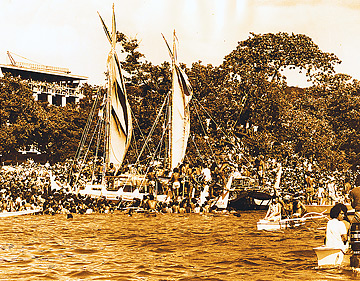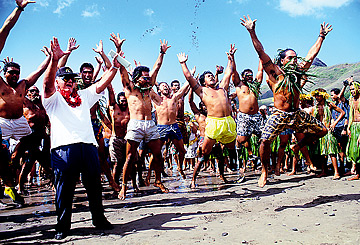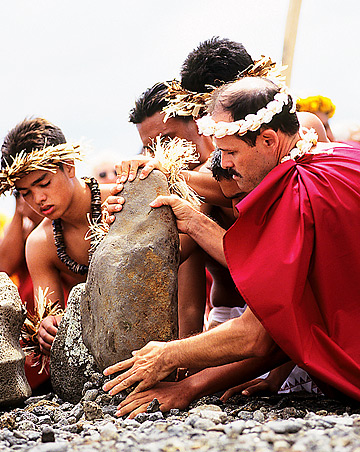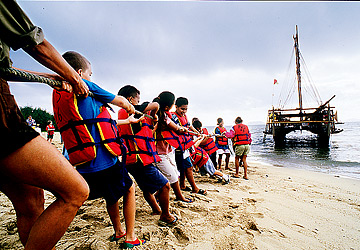HOKULE'A 30TH ANNIVERSARY
The First Voyage
Commemorating Hokule'a's Historic 1976 Journey
This month marks the 30th anniversary of the historic Hawaii-Tahiti sail of the Hokule'a, which completed the 6,000-mile roundtrip journey on July 26, 1976. Mau Piailug navigated the canoe to Tahiti without western instruments, using only ancient wayfinding methods. Hokule'a has since completed 10 long-distance voyages. Six of the major ones are charted below.

MONTE COSTA
Hundreds of Tahitians swam out to greet the Hokule'a on June 4, 1976, after the canoe arrived in Tahiti. Some climbed aboard and rode the final distance to shore.
|
|
» 6,000 total miles including 2,400 from Honolua Bay, Maui, to Papeete, Tahiti, from May 1 to June 4. Led by master navigator Mau Piailug of Satawal, Micronesia, the crew of Hokule'a proved that ancient Pacific islanders could navigate thousands of miles of ocean using traditional wayfinding methods instead of western instruments. The voyage also proved that the double-hulled canoe was capable of sailing long distances and gave credence to the theory that Polynesians were sailing great distances long before European explorers. While Americans celebrated the bicentennial of independence from England, native Hawaiians and other Pacific islanders celebrated a renaissance of ancient cultural traditions including canoe-building and sailing.
 1978
1978
» Hokule'a overturned in heavy seas in the Molokai Channel on an attempt to sail to Tahiti. The crew was rescued after two nights, except for renowned big-wave surfer and lifeguard Eddie Aikau, who had volunteered to paddle on a surfboard to Lanai for help. He was never seen again, but his valor and sense of duty gave birth to the popular saying, "Eddie Would Go."
 1980
1980
» 6,000 total miles. Hawaii to Tahiti from March 15 to April 17. Nainoa Thompson successfully guided the Hokule'a thousands of miles, becoming the first native Hawaiian in centuries to navigate using Pacific island wayfinding methods. Mau Piailug was aboard as mentor to Thompson, who was the navigator on the return trip to Hawaii from May 13 to June 6.
 1985-87
1985-87
» 14,000 total miles. Hokule'a retraced ancestral migration routes, entering into a "Voyage of Rediscovery," from June 10, 1985, to May 27, 1987. The canoe sailed from Hawaii to Aotearoa (New Zealand), and back, with stops in Tonga, Samoa, the Cook Islands, Tahiti, and the Tuamotus before returning to Hawaii. The trips helped to reawaken pride in common traditions of navigation and voyaging among other Pacific island people. Nainoa Thompson was the navigator, accompanied by Mau Piailug.

MONTE COSTA
Cook Island voyaging-canoe crew members celebrate after arriving in Taiohae, Nuku Hiva, Marquesas Islands, on April 14, 1995, during the "Na 'Ohana Holo Moana" or "The Voyaging Families of the Ocean" journey.
|
|
 1992
1992
» 9,000 total miles. This voyage, "No Na Mamo: For the Children," was designed to train a new generation of navigators. From June 17 to Dec. 1, the canoe went from Honaunau, Hawaii, to Papeete, Tahiti, and then to Ra'iatea, Aitutaki, Rarotonga and back to Tahiti, with a different navigator on each leg. On the voyage back to Hawaii from Nov. 5-Dec. 1, the Hokule'a crew contacted the crew of the space shuttle Columbia flying overhead. The crews participated in conversations with students in Hawaii about the importance of exploration. On board Columbia was Hawaii-born astronaut and Punahou graduate Lacey Veach.
 1995
1995
» 7,000 total miles. Hokule'a and Hawai'iloa sailed to Papeete, Tahiti, from Hilo from Feb. 11 to March 4 as part of the Na 'Ohana Holo Moana or "The Voyaging Families of the Ocean." The voyaging canoe Makali'i sailed from Kawaihae, Hawaii, to Tautira, Tahiti, from Feb. 28 to March 27. On the voyage from Tahiti to the Marquesas, Hokule'a, Hawai'iloa and Makali'i were joined by three South Pacific canoes. The journey celebrated the resurgence in the canoe-building arts. While preparing for the trip and building Hawai'iloa, Hokule'a crew members reached a new level of awareness of the interdependence of culture and the environment when they were unable to find koa trees in Hawaii forests large enough to build voyaging canoes. Alaska natives offered the Hawaii people the gift of logs for canoe-building.
» 1,000 total miles. On May 15, Hawai'iloa and Hokule'a left Hawaii on board a Matson container ship bound for Seattle and the "Northwest and West Coast Tours." On May 27, the two arrived in British Columbia, visiting with several native American tribes to engage in cultural and educational exchanges. Hawai'iloa continued north to Alaska to visit Ketchikan and Juneau to thank Sealaska Corp. and the Tlingit, Haida and Tsimshian tribes for donating the two Sitka spruce logs for the canoe's hulls. Hokule'a went south to share its history with Hawaiians, native Americans, and others along the West Coast, with stops in Portland, San Francisco, Santa Barbara, Long Beach, and San Diego. In San Francisco, Hokule'a was greeted by 32 paddling canoes and showered with orchids from the Golden Gate Bridge. A crowd estimated in the thousands gathered to greet the canoe.

MONTE COSTA
Holoua Stender and Kamehameha Schools students place pohaku (stones) from Hawaii during an Oct. 19, 1999 ceremony honoring the arrival of the Hokule'a at Anakena, Rapa Nui.
|
|
 1999-2000
1999-2000
» 12,000 total miles. From Hilo via Nuku Hiva and Mangareva in the Tuamotus, the voyage to Rapa Nui (Easter Island), June 15, 1999, to Feb. 27, 2000, undercut Kon Tiki explorer Thor Heyerdahl's theory that migration into the Pacific began in South America. Hokule'a showed that wind from the east shifted and became less pronounced at certain periods of the year. Hokule'a had reached the third and final corner of the Polynesian triangle -- the other corners being Hawaii and Aotearoa (New Zealand).
 2000-2001
2000-2001
» Hokule'a's millennium statewide sail, entitled "Our Islands, Our Canoe" from Sept. 22, 2000, through May 20, 2001, celebrated the vessel's 25 years of voyaging by visiting students and families in two dozen communities on Kauai, Oahu, Lanai, Molokai, Maui and the Big Island.
 2003
2003
» A cultural protocol group, Na Kupu'eu Paemoku, traveled to Nihoa aboard Hokule'a in the Northwestern Hawaiian Islands to conduct traditional ceremonies.
 2004
2004
» 2,500 total miles. Hokule'a sailed to the most Northwestern Hawaiian islands as part of a statewide educational initiative called "Navigating Change." The trip brought attention to the diverse environment in the Northwestern Hawaiian Islands, including 7,000 species in 4,500-square miles of relatively undisturbed coral reef. In a span of 18 days, a U.S. Fish and Wildlife Service educator on the Hokule'a spoke via satellite telephone to more than 1,800 students from as far away as Maryland and American Samoa.
 2005
2005
» The cultural group Na Kupu'eu Paemoku sailed to Mokumanamana (Necker Island) in the Northwestern Hawaiian Islands to conduct protocol ceremonies on the longest day of the year, June 21. Hokule'a made 25 stops through the Hawaiian islands and was met by thousands of students from 30 schools. Also in 2005, the 30th anniversary of Hokule'a's launching, the canoe carried many of the original 1976 crew to Oahu from Molokai to be honored at the Malama Kailua Festival.

MONTE COSTA
Thousands of students have learned about the Hokule'a and traditional navigation methods through programs run by the Polynesian Voyaging Society, including these elementary school students who pulled the canoe ashore at Kualoa in February 1997.
|
|

